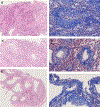Progression to fibrosing diffuse alveolar damage in a series of 30 minimally invasive autopsies with COVID-19 pneumonia in Wuhan, China
- PMID: 32926596
- PMCID: PMC8848295
- DOI: 10.1111/his.14249
Progression to fibrosing diffuse alveolar damage in a series of 30 minimally invasive autopsies with COVID-19 pneumonia in Wuhan, China
Abstract
Aims: Coronavirus disease 2019 (COVID-19), caused by severe acute respiratory syndrome coronavirus-2 (SARS-CoV-2), infection has been deemed as a global pandemic by the World Health Organisation. While diffuse alveolar damage (DAD) is recognised to be the primary manifestation of COVID-19 pneumonia, there has been little emphasis on the progression to the fibrosing phase of DAD. This topic is of great interest, due to growing concerns regarding the potential long-term complications in prolonged survivors.
Methods and results: Here we report a detailed histopathological study of 30 autopsy cases with COVID-19 virus infection, based on minimally invasive autopsies performed between February and March, 2020. The mean age was 69 years, with 20 (67%) males and 10 (33%) females and frequent (70.0%) underlying comorbidities. The duration of illness ranged from 16 to 82 (median = 42) days. Histologically, the most common manifestation was diffuse alveolar damage (DAD) in 28 (93.3%) cases which showed predominantly acute (32%), organising (25%) and/or fibrosing (43%) patterns. Patients with fibrosing DAD were one decade younger (P = 0.034) and they had a longer duration of illness (P = 0.033), hospitalisation (P = 0.037) and mechanical ventilation (P = 0.014) compared to those with acute DAD. Patients with organising DAD had a longer duration of illness (P = 0.032) and hospitalisation (P = 0.023) compared to those with acute DAD.
Conclusions: COVID-19 pneumonia patients who develop DAD can progress to the fibrosing pattern. While we observed fibrosing DAD in fatal cases, whether or not surviving patients are at risk for developing pulmonary fibrosis and the frequency of this complication will require further clinical and radiological follow-up studies.
Keywords: COVID-19 pneumonia; SARS-CoV-2; diffuse alveolar damage; fibrosis; lung pathology.
© 2020 John Wiley & Sons Ltd.
Conflict of interest statement
Conflicts of interest
None declared.
Figures


Similar articles
-
Diffuse alveolar damage (DAD) resulting from coronavirus disease 2019 Infection is Morphologically Indistinguishable from Other Causes of DAD.Histopathology. 2020 Oct;77(4):570-578. doi: 10.1111/his.14180. Epub 2020 Sep 12. Histopathology. 2020. PMID: 32542743 Free PMC article.
-
Insights into pathogenesis of fatal COVID-19 pneumonia from histopathology with immunohistochemical and viral RNA studies.Histopathology. 2020 Dec;77(6):915-925. doi: 10.1111/his.14201. Epub 2020 Oct 16. Histopathology. 2020. PMID: 32614086 Free PMC article.
-
Tracking the time course of pathological patterns of lung injury in severe COVID-19.Respir Res. 2021 Jan 29;22(1):32. doi: 10.1186/s12931-021-01628-9. Respir Res. 2021. PMID: 33514373 Free PMC article.
-
Healing after COVID-19: are survivors at risk for pulmonary fibrosis?Am J Physiol Lung Cell Mol Physiol. 2021 Feb 1;320(2):L257-L265. doi: 10.1152/ajplung.00238.2020. Epub 2020 Dec 23. Am J Physiol Lung Cell Mol Physiol. 2021. PMID: 33355522 Free PMC article. Review.
-
Autopsies in pandemics - a perspective on barriers and benefits. Is it time for a revival?APMIS. 2021 Jul;129(7):324-339. doi: 10.1111/apm.13111. Epub 2021 Mar 1. APMIS. 2021. PMID: 33645838 Free PMC article. Review.
Cited by
-
Postmortem Minimally Invasive Autopsy in Critically Ill COVID-19 Patients at the Bedside: A Proof-of-Concept Study at the ICU.Diagnostics (Basel). 2024 Jan 30;14(3):294. doi: 10.3390/diagnostics14030294. Diagnostics (Basel). 2024. PMID: 38337812 Free PMC article.
-
Converging pathways in pulmonary fibrosis and Covid-19 - The fibrotic link to disease severity.Respir Med X. 2020 Nov;2:100023. doi: 10.1016/j.yrmex.2020.100023. Epub 2020 Oct 9. Respir Med X. 2020. PMID: 33083782 Free PMC article. Review.
-
Morphopathological features induced by SARS-CoV-2 infection - a series of 57 autopsies.Histol Histopathol. 2023 May;38(5):513-524. doi: 10.14670/HH-18-561. Epub 2022 Nov 23. Histol Histopathol. 2023. PMID: 36504081
-
Pathophysiology of acute respiratory syndrome coronavirus 2 infection: a systematic literature review to inform EULAR points to consider.RMD Open. 2021 Feb;7(1):e001549. doi: 10.1136/rmdopen-2020-001549. RMD Open. 2021. PMID: 33574116 Free PMC article.
-
IL-4 and TGF-β Regulate Inflammatory cytokines and Cellular Infiltration in the Lung in Mouse-adapted SARS-CoV-2 Infection.bioRxiv [Preprint]. 2025 May 14:2025.05.13.653138. doi: 10.1101/2025.05.13.653138. bioRxiv. 2025. PMID: 40462987 Free PMC article. Preprint.
References
-
- World Health Organization (WHO). Coronavirus disease (COVID-2019) Situation Report 209. Geneva, Switzerland: World Health Organization; 2020. [accessed 2020 August 16, 2020]. Available at: https://www.who.int/emergencies/diseases/novel-coronavirus-2019.
MeSH terms
Grants and funding
LinkOut - more resources
Full Text Sources
Medical
Miscellaneous

